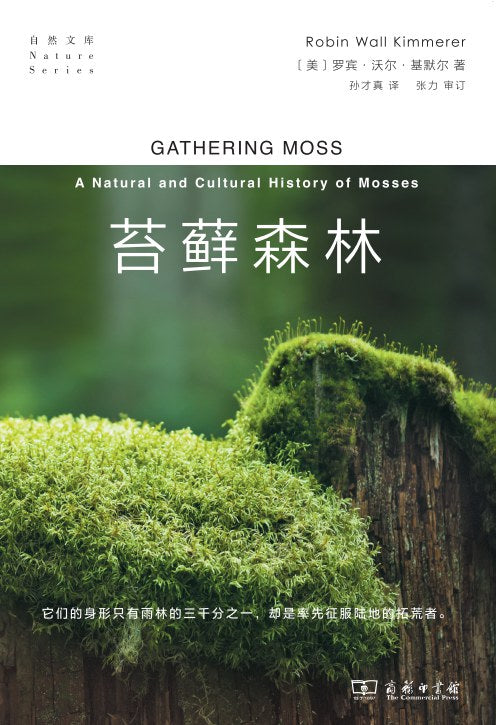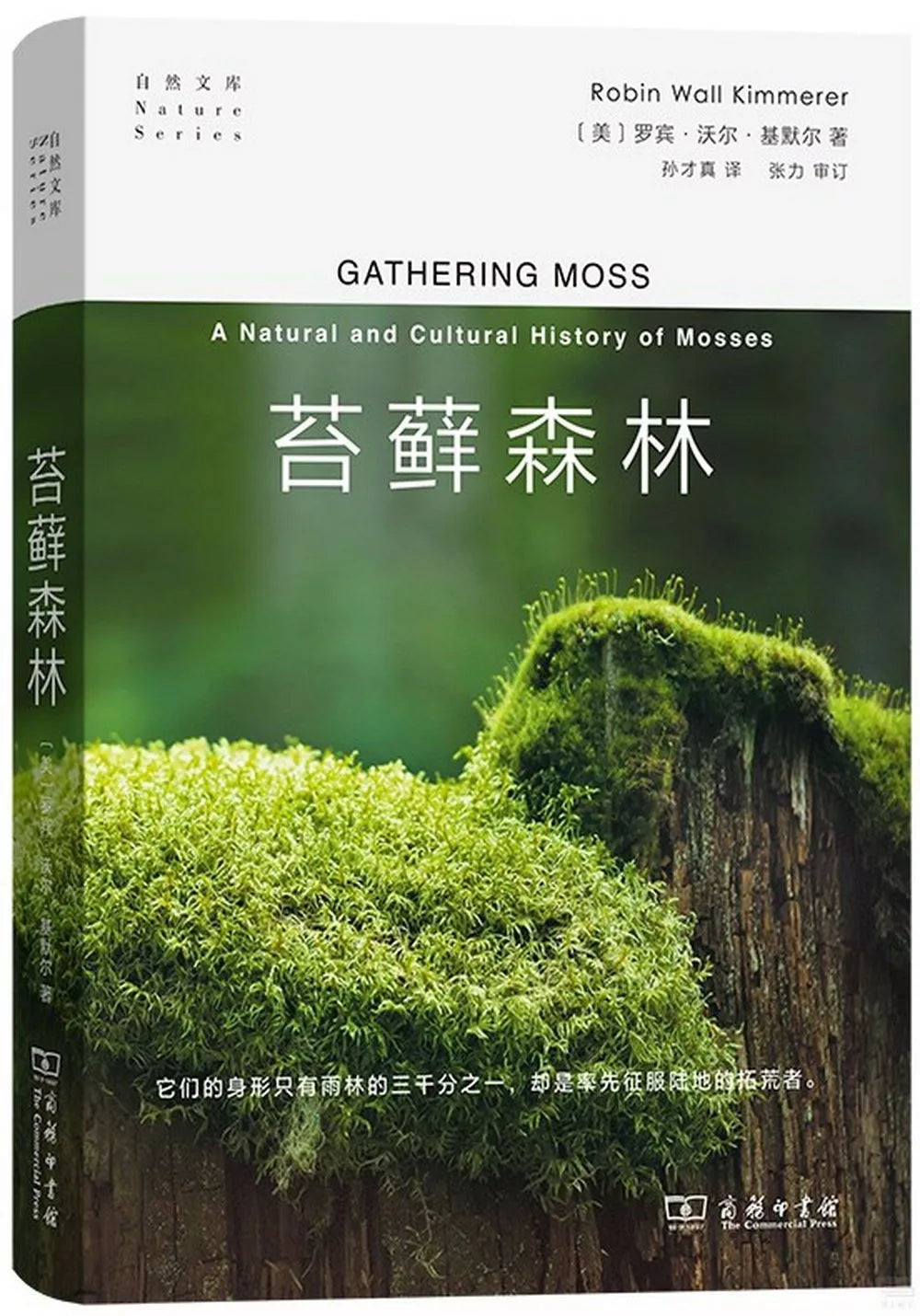1
/
of
2
Mossy Forest
Mossy Forest
Robin Wall Kilmer Sun Caizhen and Zhang Li (Review) 译
Regular price
$14.99 USD
Regular price
Sale price
$14.99 USD
Unit price
/
per
Low stock
Couldn't load pickup availability
About Book
About Book
Gathering Moss: A Natural and Cultural History of Moss
🏆2023 The 4th Pingshan Natural History Museum Book Award·Heavenly Bird of Prey Natural History Museum Good Book Reading Award The first plant to successfully reach land at the evolutionary node from aquatic to terrestrial.It is only one three thousandth the size of a forest, but it carries the global terrestrial ecosystem.
-----------
A classic of nature literature that has been a bestseller in North America for 20 years.
Well-known moss expert Zhang Li personally reviewed and recommended it with a preface!
Recommended by Peking University professors Liu Huajie and Tian Song!
-----------
【Editor's Recommendation】
Winner of the 2005 John Burroughs Medal, the highest honor in American nature literature, this book is the debut work of Robin Wall Kilmer, a leading international authority on moss. Her Native American heritage has instilled a close connection with nature from a young age. With a deep sense of connection to the land and a deeply poetic expression, she captures the warmth of even the smallest moss.
🍀 A microscopic look at terrestrial ecology: Mosses were the first plants to leave the water and colonize land. They have weathered every major global climate shift and witnessed the rise and fall of their populations. At only one-thousandth the size of a rainforest, they nourish trees, foster soil growth, and conserve water. They provide shelter for insects and nest for birds and bears. More sensitive than other species to environmental changes, they serve as indicators of heavy metal pollution. In unexpected places, mosses, in their dense, delicate forms, support the functioning of entire forests.
🍀 A vivid scientific narrative reveals the limits of evolution. Mosses lack flowers, fruits, or even roots, yet they have thrived on Earth for 400 million years. They colonize cliff faces, cracks in fallen trees, and crevices between bricks and tiles. They can survive up to 98% water loss and thrive even in bustling cities, even using human footsteps to propagate their offspring. This family boasts an incredible 22,000 species, each with its own unique morphological diversity, strong adaptability, and high tolerance to stress, making them masters of a wide range of extreme environments.
🍀Using a primitive worldview to illuminate humanistic concerns, this book, drawing on the dual perspectives of Indigenous tradition and modern science, reveals the enduring connection between mosses and humans. Linnaeus slept on a Sami blanket of golden moss while traveling in Lapland; the Chinook people stockpile moss to scrub the toxic slime off salmon skin; Indigenous peoples in the north line their boots with moss to insulate against the bitter winter chill; and in the days before diapers, babies' cradles were filled with dried peat moss...
🍀The translation has been carefully polished and reviewed by authoritative experts. The translation was carefully considered and completed by Sun Caizhen, a senior natural history enthusiast and emerging self-media person. Zhang Li, a well-known domestic moss expert, was specially invited to review and check it to ensure scientific and accurate expression.
🍀 Eye-catching moss ecological photography. The color illustrations before the article were all taken by Zhang Li in the wild environment of mosses. More than 20 photos were carefully selected to correspond to the species in the book. The structural characteristics that embody billions of years of evolutionary wisdom are clearly revealed, presenting a shocking microscopic beauty.
Mosses are often overlooked, even among nature enthusiasts, and few truly pay attention to them. As the oldest terrestrial plant, mosses successfully conquered the primitive "barren land" more than 400 million years ago. Although only one-thousandth the size of a rainforest, they play an unexpectedly important role in nourishing trees and maintaining ecological balance. Their tiny, delicate branches and leaves quietly support entire forests.
This book contains nineteen essays by Kimmel, each of which tells the unique survival wisdom of a moss. As a member of the Potawatomi tribe of North America, the author has a reverent attitude towards all things in nature. She regards each moss as an old friend and skillfully integrates the botanical characteristics of mosses into her own life experiences.
In these texts, there are her daily interactions with her daughter and neighbors, the exciting adventure of collecting moss in the wild, the continuous exploration of scientific experiments in the forest, and the "natural theft" carried out by super-rich people in the name of ecological restoration... These philosophical stories lead us to break through the limitations of body size, enter the kingdom of "plant dwarfs", and experience the profound enlightenment contained in the tiny life of moss.
【Content Introduction】
The author takes the unique biological characteristics of different types of mosses as the theme, combines his own life and scientific research experience, and uses beautiful prose-like language to introduce the role of mosses in nature, indigenous civilizations, modern urban environments, and even the global ecological context.
As the oldest land plants, mosses are true pioneers, transforming barren rock and soil into environments suitable for the germination and growth of other plant seeds. These essays offer a fresh perspective on the world, using the tiny, often overlooked mosses as a prism to reflect profound reflections on the relationship between humans and nature.
【Media Reviews】
“Moss is a model for how we live.”
—The Guardian
"Every time I go for a walk, I think of Kimmel's words. In fact, I thank Kimmel every day for her endless source of spiritual and spiritual knowledge."
—Pulitzer Prize winner Richard Powers “She makes even the smallest moss feel warm.”
Zhang Li, a veteran bryophyte researcher and popular science education expert, said, "Even those who claim to love plants may have long overlooked mosses because they are too small and don't produce flowers or fruits. Author Kimmel, a descendant of Native Americans, also reminds us that observing mosses with an objective scientific perspective isn't enough! We also need to draw on other local knowledge. 'Only when our brain, body, emotions, and spirit have all grasped something can we say we understand it.' Indeed, understanding mosses helps us understand ecology and the world. Moss Forest is a model of nature writing, and the translation is fluent."
--Peking University Professor Liu Huajie: "This is a small book filled with wisdom and joy. I often encountered surprises while reading it, like being bathed in a spring breeze or hearing celestial music. The artistic conception in the book is worth savoring again and again. Moss is tiny, yet also rich, so rich that it is a world in itself. This tiny world requires one to bend down and change perspective to see it. From the invisible to the visible, it is a magical transformation, like a pavilion emerging from the clouds. The author is an ecologist and a descendant of indigenous people, naturally blessed with two perspectives on the world. The translator's writing is beautiful, and his knowledge and sentiment are just right."
——Tian Song, professor at Southern University of Science and Technology
Publication Date
Publication Date
2023-07-01
Publisher
Publisher
商务印书馆
Imprint
Imprint
Pages
Pages
272
ISBN
ISBN
9787100220828
share



